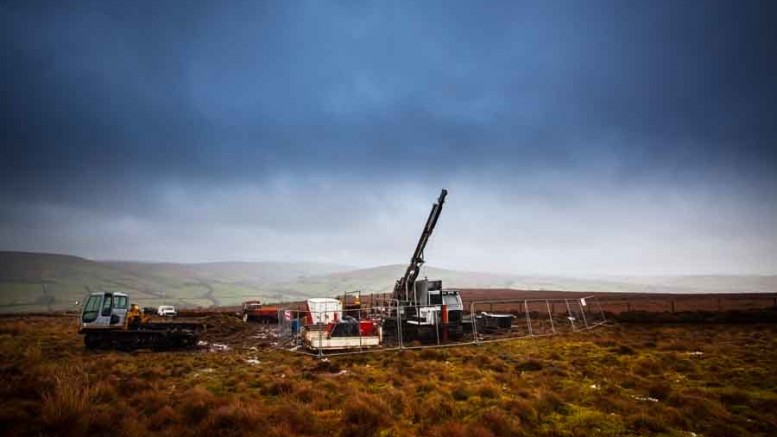Focusing its exploration efforts in an established, low-risk mining jurisdiction is paying off for Toronto-based Dalradian Resources (DNA-T). The company has already outlined a multi-million ounce gold resource at its Curraghinalt deposit, 120 km west of Belfast in Northern Ireland, and results from a 2012 exploration program seem to promise further growth at the 840-sq.-km Tyrone project, also in Northern Ireland.
Market activity started heating up for Dalradian following an updated preliminary economic assessment (PEA) released in July that modelled a 1,700 tonne-per-day underground operation at Curraghinalt that would produce 145,000 oz. gold annually at operating costs of around US$532 per oz.
Since the release, Dalradian’s shares have skyrocketed 103%, or 70¢, and remain strong at $1.38 at press time. The impetus behind the market surge has been aggressive drilling at a project that is closing in on the development stage. Dalradian completed 9,500 metres worth of drilling in the second half of 2012, and total exploration efforts at Curraghinalt are expected to exceed 50,000 metres by the end of 2013.
Dalradian followed up its PEA with the Alwories discovery, which resulted from trend-scale geochemical surveying that allowed the company to identify a series of anomalies. Alworie lies 1.7 km east of Curraghinalt and demonstrates equally impressive grades highlighted by 4.7 metres grading 14.82 grams gold per tonne from 236 metres depth in hole 12-CT-173, and 2.2 metres averaging 14.1 grams gold from 186 metres depth in hole 12-CT-162.
“It looks like the time, cost and effort we put into completing our recent [geochemical survey] was well spent. Our first hole of the anomaly drilling program has come back a zinger,” CEO Patrick F.N. Anderson says in an interview. “The Alwories discovery is a direct result of our recent gold-in-soil anomalies and is only the first of multiple targets to be tested.”
Meanwhile, Dalradian is cutting strong grades during its infill and stepout programs at Curraghinalt, which have expanded the extent of the deposit at depth and westward along strike.
Highlights from late 2012 include: 2.3 metres averaging 47.94 grams gold from 359 metres in hole 157; 3.97 metres of 38 grams gold from 586 metres in hole 156; 2.5 metres of 18.99 grams gold from 201 metres in hole 167; and 1.7 metres of 17.55 grams gold from 256 metres in hole 161.
In addition to an existing set of seven primary gold-bearing, quartz-sulphide veins, Dalradian has identified a secondary system — dubbed the “C vein zones” — that is interpreted as a steeply dipping trend that runs at a low angle to the main vein system. The company continues to evaluate the impact of the secondary discovery on a future resource expansion.
“Our new discovery shows that the hanging wall and footwall zones are also gold-bearing. While it is early days in understanding this new vein set, it has the potential to be a game changer by adding grade to areas previously considered to be barren,” Anderson says.
Dalradian has continued to build momentum in early 2013. The company announced a new gold target identified by prospecting. The Fallagh discovery lies 3.5 km southwest of Curraghinalt, with the highest-grade float samples — highlighted by 30 grams gold per tonne — harvested from a creek lying 800 metres down-slope from a cluster of gold-bearing, quartz-carbonate-pyritic vein material.
“Follow up crews will tighten the soil geochem grid on this target and immediately prioritize for drilling,” Anderson says.
Dalradian is already sitting on global resources at Curraghinalt totalling 6.6 million tonnes grading 12.78 grams gold for 2.7 million oz. at a 5 gram gold cut-off. The bulk of that sits in the inferred category with 5.45 million tonnes averaging 12.74 grams gold for 2.23 million contained oz. gold, though the company is updating the resource.
Another attractive aspect of the project is a relatively low anticipated capital expenditure. Curraghinalt is expected to cost just US$192 million in upfront development costs, which by modern standards is affordable, for a gold operation with an annual output exceeding 100,000 oz. gold.
On Jan. 20, BMO Capital Markets analyst John Hayes initiated coverage on Dalradian with an “outperform” rating and a US$3.14-per-share valuation.
Hayes notes that in addition to the existing discovery, the company holds 840 sq. km along a “prospective and relatively unexplored greenstone belt that could yield further discoveries.”
“Smaller scale, high-grade projects like Curraghinalt are more in favour with both managements and investors at present because they have smaller physical and financial footprints and are more easily managed,” Hayes writes in his inaugural research report on Dalradian. “The timing of a production decision will likely depend in part on how resource growth and conversion from exploration could influence project scale. Financing and permitting are also timing considerations.”
Dalradian reported US$28 million in cash and equivalents to end the third quarter of 2012, and the company is expected to have sufficient capital to cover exploration activities through the first half of 2013.
Dalradian has three drills turning at Curraghinalt to start the year, with two focused on infill and resource work at the main deposit, and one working at the Alwories discovery.
The company will also continue its geochemical work in a bid to identify additional drill targets, and plans to field test a new geophysical system aimed at uncovering further sulphide-associated gold mineralization.


Be the first to comment on "Dalradian finds gold in Northern Ireland’s hills"